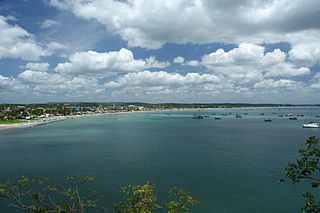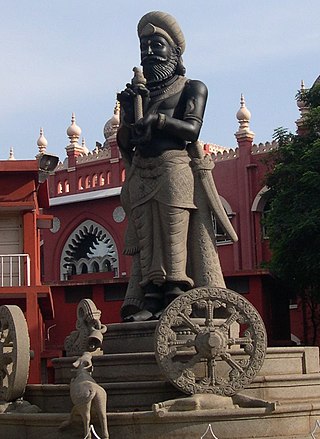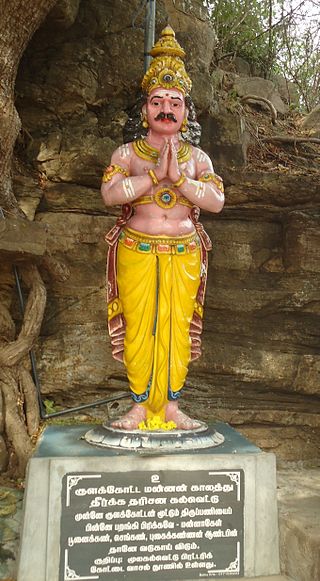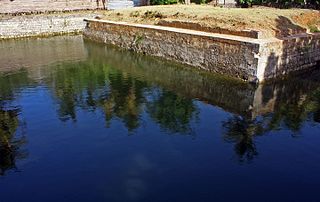
Trincomalee, historically known as Gokanna and Gokarna, is the administrative headquarters of the Trincomalee District and major resort port city of Eastern Province, Sri Lanka. Located on the east coast of the island overlooking the Trincomalee Harbour, Trincomalee has been one of the main centres of Sri Lankan Tamil speaking culture on the island for nearly a millennium. With a population of 99,135, the city is built on a peninsula of the same name, which divides its inner and outer harbours. It is home to the famous Koneswaram temple from where it developed and earned its historic Tamil name Thirukonamalai. The town is home to other historical monuments such as the Bhadrakali Amman Temple, Trincomalee, the Trincomalee Hindu Cultural Hall and, opened in 1897, the Trincomalee Hindu College. Trincomalee is also the site of the Trincomalee railway station and an ancient ferry service to Jaffna and the south side of the harbour at Muttur.

Mahāvaṃsa is the meticulously kept historical chronicle of Sri Lanka until the period of Mahasena of Anuradhapura. It was written in the style of an epic poem written in the Pali language. It relates the history of Sri Lanka from its legendary beginnings up to the reign of Mahasena of Anuradhapura covering the period between the arrival of Prince Vijaya from India in 543 BCE to his reign and later updated by different writers. It was first composed by a Buddhist monk named Mahanama at the Mahavihara temple in Anuradhapura in the 5th or 6th-century CE.
The caste systems in Sri Lanka are social stratification systems found among the ethnic groups of the island since ancient times. The models are similar to those found in Continental India, but are less extensive and important for various reasons. Modern times Sri Lanka is often considered to be a casteless society in south asia.

The Nallur Kandaswamy Kovil is a Hindu temple, located in Nallur, Northern Province, Sri Lanka. The presiding deity is Murugan (Kartikeya) in the form of the divine spear vel in the sanctum, the primary shrine, and in other forms, namely, Shanmugar, Muthukumaraswami, Valli Kanthar with consorts Valli and Deivayanai, and Dandayuddhapani, sans consorts in secondary shrines in the temple.

The Arya Chakravarti dynasty were kings of the Jaffna Kingdom in Sri Lanka. The earliest Sri Lankan sources, between 1277 and 1283, mention a military leader of this name as a minister in the services of the Pandyan Empire; he raided the western Sri Lankan coast and took the politically significant relic of the Buddha's tooth from the Sinhalese capital city of Yapahuwa. Political and military leaders of the same family name left a number of inscriptions in the modern-day Tamil Nadu state, with dates ranging from 1272 to 1305, during the late Pandyan Empire. According to contemporary native literature, such as Cekaracecekaramalai, the family also claimed lineage from the Tamil Brahmins of the prominent Hindu pilgrimage temple of Rameswaram in the modern Ramanathapuram District of India. They ruled the Jaffna kingdom from the 13th until the 17th century, when the last of the dynasty, Cankili II, was ousted by the Portuguese.

Ellalan, also referred to as Elara the Pious, and by the honorific epithet Manu Needhi Cholan, was a member of the Tamil Chola dynasty in Southern India, who upon capturing the throne became king of the Anuradhapura Kingdom, in present-day Sri Lanka, from 205 BCE to 161 BCE.
Nalavar is a Tamil caste found in Sri Lanka. They were traditionally occupied in palm tree climbing and toddy tapping.

Cankili I, also known as Segarasasekaram, is the most remembered Jaffna kingdom king in the Sri Lankan Tamil history. He was active in resisting Portuguese colonial inroads into Sri Lanka. He inherited his throne via palace intrigues in which a number of heirs died under mysterious circumstances. Ultimately, he was removed from power by a local uprising that led to his son Puviraja Pandaram taking nominal power from him.

Nallur is an affluent suburb in Jaffna, Sri Lanka. It is located 3 km south from Jaffna city centre. Nallur is most famous for Nallur Kandaswamy temple, one of Sri Lanka's most sacred place of pilgrimage for Sri Lankan Hindus. Nallur is also famous for being the historical capital of the old Jaffna Kingdom and birthplace of renowned philosopher and theologian, Arumuka Navalar.
Yalpana Vaipava Malai is a book written by a Tamil poet named Mayil Vaakanaar in 1736. This book contains historical facts of the early Tamil city of Jaffna. The book may have been written around 1736, during the Governorship of Jan Maccara, the then Dutch Governor of Jaffna. It was translated from Tamil by C. Brito, and was first published in 1879. The work is looked upon as one of great authority among the Tamils of Jaffna.
History of Eastern Tamils of Sri Lanka is informed by local legends, native literature and other colonial documents. Sri Lankan Tamils are subdivided based on their cultural, dialects & other practices as into Northern, Eastern and Western groups. Eastern Tamils inhabit a region that is divided into Trincomalee District, Batticalo District and Ampara District.
Martanda Cinkaiariyan ascended the throne of Jaffna Kingdom under the throne name Pararasasekaram III. He is one of the early Aryacakravarti kings about whom historical and epigraphical evidence is available. He was noted by Ibn Battuta in his well-known travelogue as well as he has left behind a few inscriptions. He oversaw the international trade of the Jaffna kingdom with Yemen via the kingdom's powerful trading ships. Martanda Cinkaiariyan accompanied Battuta to the peak of Sivanoli Padam Malai along with Yogis and other Hindus and companions of the king who visited the sacred Shiva site annually.

The Vanni chieftaincies or Vanni tribes was a region between Anuradhapura and Jaffna, but also extending to along the eastern coast to Panama and Yala, during the Transitional and Kandyan periods of Sri Lanka. The heavily forested land was a collection of chieftaincies of principalities that were a collective buffer zone between the Jaffna Kingdom, in the north of Sri Lanka, and the Sinhalese kingdoms in the south. Traditionally the forest regions were ruled by Vedda rulers. Later on, the emergence of these chieftaincies was a direct result of the breakdown of central authority and the collapse of the Kingdom of Polonnaruwa in the 13th century, as well as the establishment of the Jaffna Kingdom in the Jaffna Peninsula. Control of this area was taken over by dispossessed Sinhalese nobles and chiefs of the South Indian military of Māgha of Kalinga (1215–1236), whose 1215 invasion of Polonnaruwa led to the kingdom's downfall. Sinhalese chieftaincies would lay on the northern border of the Sinhalese kingdom while the Tamil chieftaincies would border the Jaffna Kingdom and the remoter areas of the eastern coast, north western coast outside of the control of either kingdom.

Portuguese Ceylon is the name given to the territory on Ceylon, modern-day Sri Lanka, controlled by the Portuguese Empire between 1597 and 1658.
The Tissanayagam family(Mathakal), sometimes also spelled Tissainayagam, is a Jaffna Tamil family descended from Tissanayaka Mudali of Mannanpulam Mathakal. Tissanayaka Mudali (circa 1730) was a Tamil chieftain who lived during Dutch times (1658–1798).
Vickrama Cinkaiariyan was the fourth of the Aryacakravarti kings of Jaffna Kingdom. Author of the book “Ancient Jaffna” C. Rasanayagam calculated that he has been ruled Jaffna from 1279 to 1302. Yalpana Vaipava Malai says during his rule the county was in disorder. Riot occurred between Sinhalese and Tamils. Vickrama Cinkaiariyan ordered death sentences 17 Sinhalese and imprisoned many Sinhalese after the murder of 2 Tamils.

The Pre-Anuradhapura period of Sri Lankan history begins with the gradual onset of historical records in the final centuries of the prehistoric period and ending in 437 BC. According to the Mahavamsa, the original inhabitants of Sri Lanka are the Yakshas and northern Naga tribes. Sinhalese history traditionally starts in 543 BC at the arrival of Prince Vijaya, a semi-legendary king who was banished from the Indian subcontinent with his 700 followers, and is recorded in the Mahavamsa chronicle. This period was succeeded by the Anuradhapura period.

Kulakkottan was an early Chola king and descendant of Manu Needhi Cholan who was mentioned in chronicles such as the Yalpana Vaipava Malai and stone inscriptions like Konesar Kalvettu. His name Kulakkottan means 'builder of tank and temple'.

Yamuna Eri is an ancient pond situated in Nallur, Jaffna, Sri Lanka. In 1948, it was listed as one of the protected archaeological monuments in the Jaffna District by the Sri Lankan government.
Madapalli is a caste found mainly in the northern part of Sri Lanka. Found today as a subcaste of the Sri Lankan Vellalar, the Madapallis were considered an independent caste until recently.










